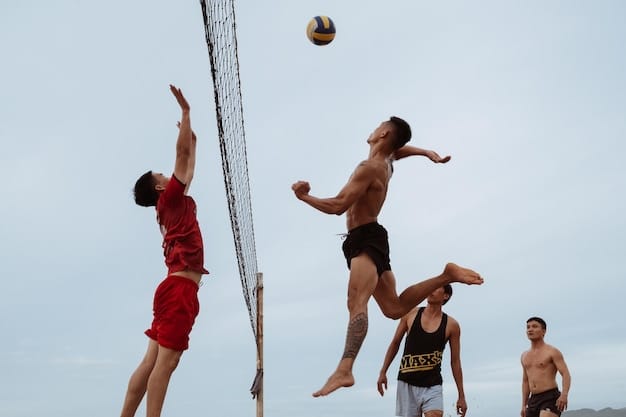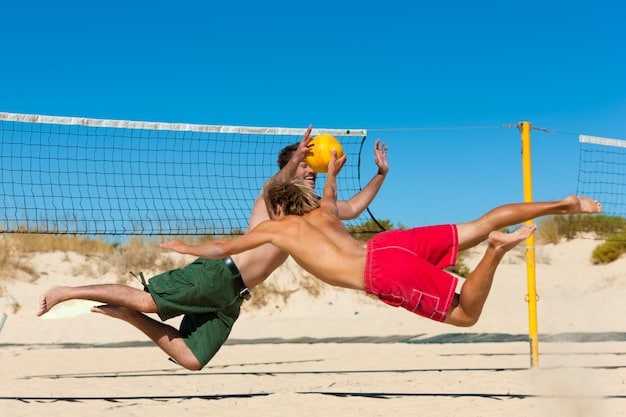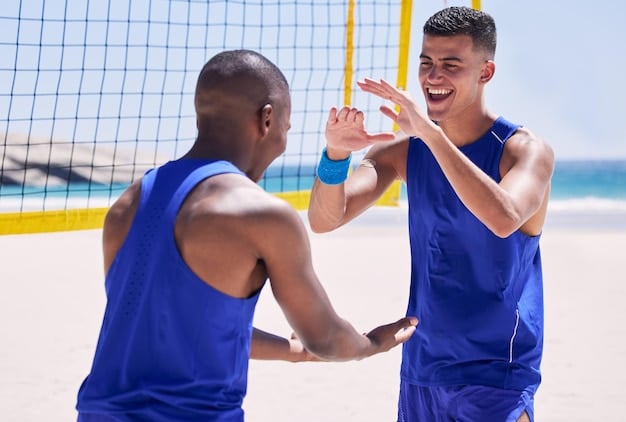Beach Volleyball Strategies: Boost Your Game by 15%

Beach Volleyball Strategies: Improve Your Game by 15% with These Advanced Techniques explores key tactics, including precise serve placement, strategic blocking, versatile offensive plays, and enhanced communication, to significantly elevate your beach volleyball performance.
Ready to take your beach volleyball skills to the next level? Uncover the **Beach Volleyball Strategies: Improve Your Game by 15% with These Advanced Techniques** that will transform your game from amateur to formidable.
Mastering Serve Placement for Beach Volleyball
Strategic serving is a cornerstone of beach volleyball success. It’s not just about getting the ball over the net; it’s about dictating the play and exploiting your opponent’s weaknesses.
Targeting Weaknesses
Identify the less skilled passer on the opposing team and consistently serve to them. This can disrupt their rhythm and force errors.
Serving Deep vs. Short
Mix up your serve depth. A deep serve can push opponents off the net, while a short serve can catch them off guard and force awkward passes.
- 🎾 Aim for the lines: Serving near the sidelines puts pressure on the receiving team.
- ☀️ Use the sun: Serve high and into the sun to make it difficult for the receiver to track the ball.
- 💨 Consider the wind: Adjust your serve trajectory to account for wind conditions, maximizing its effectiveness.
Varying your serve placement keeps your opponents guessing and prevents them from settling into a comfortable receiving pattern. It’s a crucial element of **beach volleyball strategies**.

Strategic Blocking Techniques in Beach Volleyball
Effective blocking is about more than just jumping high. It’s about reading your opponent, anticipating their attacks, and positioning yourself to disrupt their shots.
Reading the Attacker
Pay attention to the attacker’s approach, arm swing, and body language. These cues can provide valuable information about where they intend to hit the ball.
Forming a Solid Block
Maintain a strong, stable base with your hands reaching high and close together. This maximizes your blocking surface and prevents the ball from squeezing through.
Communicating with Your Partner
Clear communication is essential for coordinated blocking. Use hand signals and verbal cues to indicate your blocking intentions and adjust your positioning accordingly.
- 🖐️ Line block: Direct the hitter towards the line.
- 📐 Angle block: Force the hitter to hit cross-court.
- 💪 Soft block: Absorb some of the ball speed to give your partner time to dig.
Mastering blocking techniques is a key element to **improve your game by 15%**. A well-timed block can shut down an opponent’s attack and shift the momentum of the game.
Offensive Play Calling and Versatility
A predictable offense is an easily defended offense. To keep your opponents guessing, you need to develop a versatile attack strategy with varied play calls.
The Importance of Set Variety
Don’t rely on the same set every time. Mix up your sets with quick sets, high sets, and back sets to create different hitting opportunities.
Utilizing the Entire Court
Varying your attack angles is another essential step in **beach volleyball strategies**. Don’t just hit cross-court every time. Use the entire court to open up hitting lanes and create scoring opportunities.
Recognizing Defensive Weaknesses
Scan the court for gaps in the defense and exploit them with well-placed shots. This requires quick thinking and adaptability.
A dynamic offense keeps the defense guessing and increases your chances of scoring key points. Remember that versatility is key.
Advanced Communication Strategies on the Sand
Clear communication is the glue that holds a successful beach volleyball team together. It allows you to anticipate each other’s moves.
Pre-Serve Signals
Use hand signals before each serve to communicate your intended serve placement. This allows your partner to adjust their positioning and be ready for the return.
In-Play Communication
Verbal cues during play are crucial for coordinating your defense and offense. Call out the hitter’s tendencies, identify open areas on the court, and communicate your intentions clearly.
Post-Point Discussions
After each point, take a moment to discuss what worked well and what needs improvement. This allows you to make adjustments on the fly and stay one step ahead of your opponents.
- 🗣️ Calling for the ball: Use clear and concise language to indicate when you’re ready to hit.
- 🤝 Signaling block intentions: This helps the defender know where to position themselves.
- 🤔 Discussing strategy during timeouts: Take a minute to get back on the same page.
Robust communication is the foundation of any successful beach volleyball team. It’s the hidden key that takes **beach volleyball strategies** from basic to brilliant.

Mental Toughness and Resilience in Beach Volleyball
Beach volleyball is as much a mental game as it is a physical one. The ability to stay focused, positive, and resilient under pressure is essential for success.
Handling Errors with Grace
Everyone makes mistakes. The key is to learn from them and move on. Don’t dwell on past errors; focus on the next point.
Maintaining a Positive Attitude
A positive attitude can be contagious. Encourage your partner, celebrate successes, and stay upbeat even when you’re facing adversity.
Visualizing Success
Before each game, take a few minutes to visualize yourself playing well. Imagine making great plays, hitting clutch shots, and winning key points.
By cultivating mental toughness and resilience, you can overcome challenges and achieve your full potential on the beach. Your journey to **improve your game by 15%** depends on it.
Practicing Drills to Sharpen Your Skills
Consistent practice is key to mastering any skill. Incorporate these drills into your training routine to sharpen your game:
Serving Accuracy Drill
Set up targets on the court and practice serving to specific locations. This will improve your serve placement and consistency.
Blocking Reaction Drill
Have a partner attack at the net while you focus on reacting quickly and forming a solid block. This will improve your blocking timing and technique.
Hitting Variety Drill
Practice hitting a variety of sets from different locations on the court. This will improve your hitting versatility and shot selection.
- 🎯 Target practice: Improve serving accuracy by aiming at specific zones.
- 🏃♀️ Blocking agility: Enhance lateral movement and timing by practicing blocking various attack angles.
- 🏐 Offensive flow: Boost offensive coordination with drills that simulate game scenarios.
Regular practice is the foundation of any successful beach volleyball player. Use these drills to refine your skills and improve your overall game. Make strategic practice sessions a cornerstone of your **beach volleyball strategies**.
| Key Element | Brief Description |
|---|---|
| 🎯 Serve Placement | Target weaknesses, vary depth, and consider environmental factors. |
| 🛡️ Blocking | Read, form a barrier, and communicate blocking intentions. |
| 🏐 Offensive Versatility | Mix sets, use the entire court, and look for defensive gaps. |
| 🗣️ Communication | Use signals pre-serve, talk during play, and discuss post-point. |
Frequently Asked Questions
▼
Targeting the weaker passer on the opposing team is a highly effective serve strategy. It disrupts their offense and increases your chances of forcing an error.
▼
Practice reading the attacker’s cues, maintaining a strong blocking form, and communicating clearly with your partner to coordinate your blocking efforts effectively.
▼
A versatile offense keeps the defense guessing. Mixing sets and attack angles creates more opportunities to exploit defensive weaknesses and score points consistently.
▼
Mental toughness helps you handle errors, maintain a positive attitude, and stay focused under pressure. All of these contribute to overall performance and resilience on the court.
▼
Strategic serving, when combined with the blocking, offensive, and mental strategies discussed, can certainly lead to a significant improvement in your overall game, potentially by 15% or more.
Conclusion
By mastering these advanced **beach volleyball strategies**, from precise serve placement and strategic blocking to versatile offensive plays and enhanced communication, you’ll be well-equipped to elevate your game and achieve a significant performance boost on the sand. Remember to practice consistently and cultivate mental toughness to unlock your full potential.





